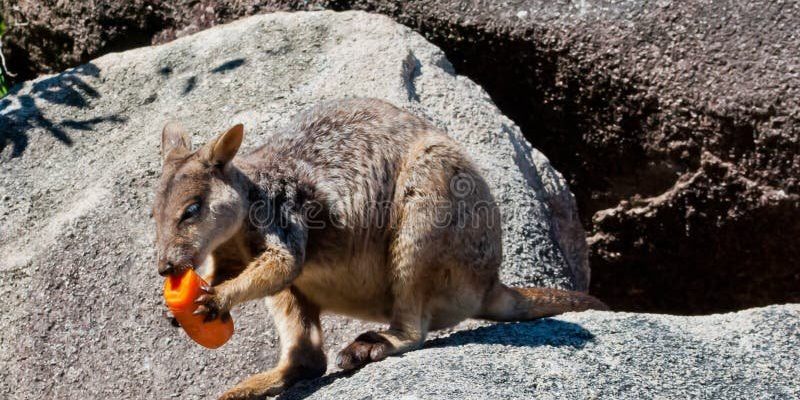
They’re not just passive grazers, either. Wallabies employ a mix of clever eating techniques and some interesting hunting strategies to get the most out of their environment. So, let’s dive into the world of wallabies to uncover their dietary habits and how they navigate their habitats. It’s a little adventure that reveals how these creatures thrive in the wild!
What Do Wallabies Eat?
Wallabies have a pretty diverse diet, mostly centered around **grasses, leaves, and other vegetation**. Think of them as nature’s lawnmowers, keeping the grasslands tidy while they indulge. Their primary food sources include:
- Grasses
- Leaves from shrubs and bushes
- Herbs
- Flowers and fruits when they’re in season
They’re selective feeders, often preferring softer, younger plant material over tougher ones. This is important since young leaves and shoots are generally more nutrient-rich, giving wallabies the energy they need to hop around. You might be wondering how they find these tasty snacks. Their excellent sense of smell helps them locate the freshest food, just like how you might sniff out a delicious pizza in a crowded restaurant!
Feeding Behavior
Wallabies feed during the early morning and late afternoon. They’ve adapted to this routine because it helps them avoid the harsh midday sun, which can be quite intense in Australia. During these cooler hours, you might catch them nibbling on grass or munching on leaves, their long ears perked up for any sounds of danger.
When it comes to eating, wallabies can be quite picky. They use their strong, sharp front teeth to clip their food. Unlike cows, which have flat teeth for grinding, wallabies have teeth designed for snipping, giving them an edge in selecting the best bites. This way, they can efficiently process their meals while keeping an eye out for predators like dingoes or eagles.
Digestion and Nutritional Needs
Wallabies are ruminants, but they don’t do things quite like cows. Instead of having multiple stomachs, they have a single stomach that acts in a similar way. Their digestive process is lengthy. Here’s how it works:
1. **Grazing**: They eat their food quickly, swallowing it without much chewing.
2. **Ruminating**: Later, they’ll find a safe spot and bring some food back to chew it thoroughly. This helps break it down, allowing them to extract maximum nutrients.
3. **Fermentation**: Like other herbivores, the food ferments in their stomach, giving them energy while also producing gas. This is why you might see them lift their tails; it’s a natural way to relieve that buildup!
This unique way of digesting allows wallabies to thrive in their often tough, arid environments. It’s like having a personal chef that prepares the food for you at just the right time!
Hunting Strategies? Not Quite!
You might be surprised to learn that wallabies aren’t exactly hunters in the traditional sense. They don’t chase other animals for meals like predators do. Instead, they rely on their **predator avoidance strategies**. Here’s how it works:
– **Camouflage**: Their fur often blends into the environment, making it difficult for predators to spot them.
– **Group Behavior**: Wallabies tend to gather in groups, known as mobs. This social structure helps protect individuals—if one wallaby spots danger, it can alert the others.
But what about competition for food? Wallabies can face competition from other herbivores, like kangaroos. In those situations, they employ a strategy that resembles a tactical retreat. If a wallaby feels threatened or if there are too many competitors, it might move to a less populated area where it can find food more securely.
Seasonal Changes in Diet
Like many animals, wallabies adjust their diet with the seasons. During summer, when food is plentiful, they can eat a wide variety of plants, but as winter comes and food becomes scarce, they have to adapt. They can even fast for short periods and rely on stored energy when things get tough. This is where their smart foraging skills come into play, as they remember where to find the best food sources throughout the year.
During the dry seasons, wallabies may also consume tougher vegetation that’s higher in fiber, which is less nutritious but essential for survival. It’s a bit like us during a winter storm when we might have to dig into the pantry for canned goods.
The Role of Water in Their Diet
Water is another crucial aspect of a wallaby’s diet. Although they can drink from water sources like rivers or ponds, they also get moisture from the plants they eat. In dry regions, this is especially important. Wallabies have evolved to conserve water efficiently, similar to a well-designed water bottle that keeps your drink cool for hours.
When water is scarce, they become more nocturnal, venturing out at night to graze when it’s cooler and may have access to dew on the grass. It’s a smart way to stay hydrated without risking exposure to predators during the day.
In conclusion, wallabies have adapted beautifully to their environments, using a blend of herbivorous habits and survival strategies. Their diet consists mainly of grasses and leaves, and they have developed unique ways to find and eat their food. While they may not be hunters in the traditional sense, their ability to evade predators and adapt to seasonal changes is impressive.
Understanding wallabies gives us a glimpse into the delicate balance of nature. Just like us, they have to navigate challenges and find food in a world full of competition. Next time you think of wallabies, remember that there’s a whole lot of strategy and adaptation behind those cute little faces. It’s a wild world out there, and these creatures are thriving in their own special way!

